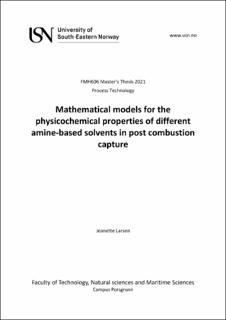Mathematical models for the physicochemical properties of different amine-based solvents in post combustion capture
Master thesis
Permanent lenke
https://hdl.handle.net/11250/2832843Utgivelsesdato
2021Metadata
Vis full innførselSamlinger
Sammendrag
CO2 emissions caused by human activity is an increasing problem in today’s society. In order to reduce the environmental impact, it is important to be able to design CO2 capture modules from correct physicochemical properties. This includes accurately predicting the density and viscosity of pure, aqueous and CO2 loaded aqueous amine solutions. The main objective of this thesis is therefore to explore mathematical correlations for physicochemical properties of different amine-based solvents applied to post combustion CO2 capture.
13 developed correlations have been evaluated by comparing the maximum deviation of fitted models to the measured property, and by determining the average absolute relative deviation (AARD%). All calculations were performed by utilizing Python 3.6 and MATLAB R2020b. Post-processing of results were done in Excel.
The result of this thesis indicates that viscosity for aqueous amines are better correlated to Eyring’s viscosity model based on the NRTL relation rather than with a Redlich-Kister correlation. This can be viewed by the achieved AARD% of aqueous MEA showing a value of 2.39 for Redlich-Kister, 1.87 for Eyring-NRTL and 1.88 for the segment-based Eyring-NRTL model. The same behavior was observed in calculations for aqueous MDEA. In addition, two correlations by Karunarathne et al. gave satisfactory results for CO2 loaded aqueous MEA in the calculation of density and viscosity. The relations gave an AARD% of 0.15 and 0.53 respectively.
Lastly, it was found that by using an additional correlation from the research by Karunarathne et al., NRTL parameters from VLE data simulated in Aspen Plus may be used to estimate mixture viscosities.
